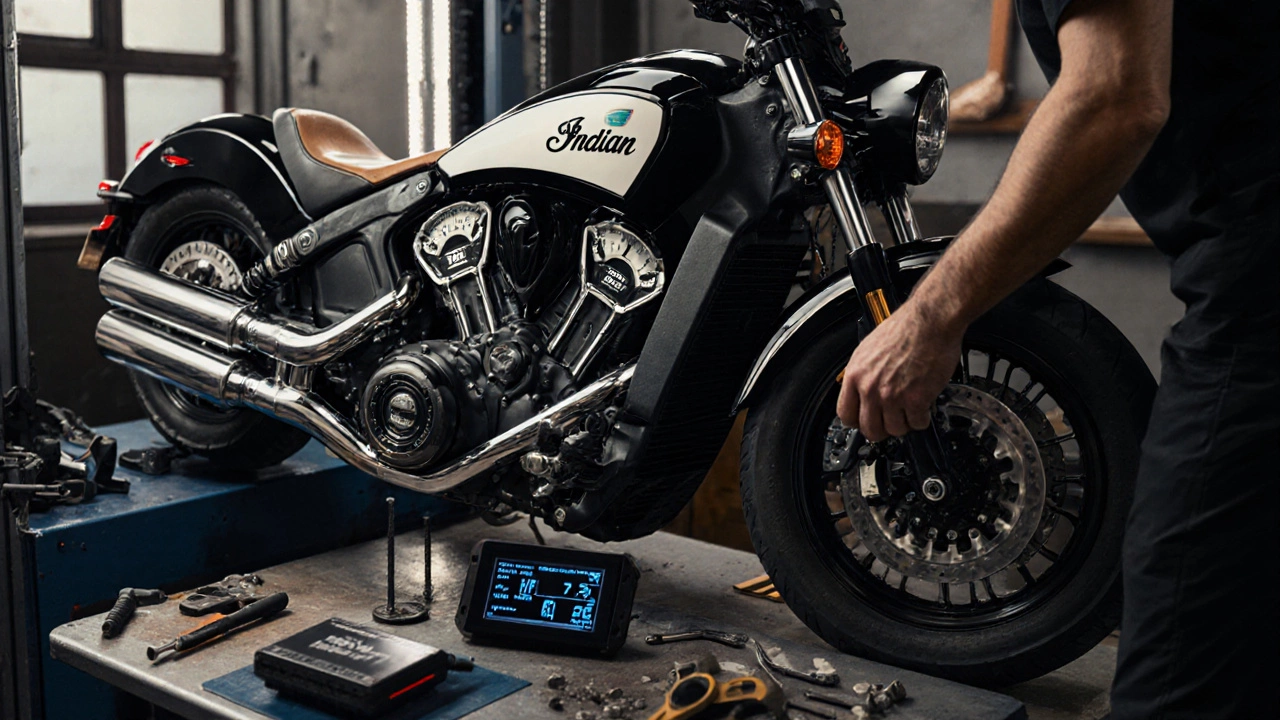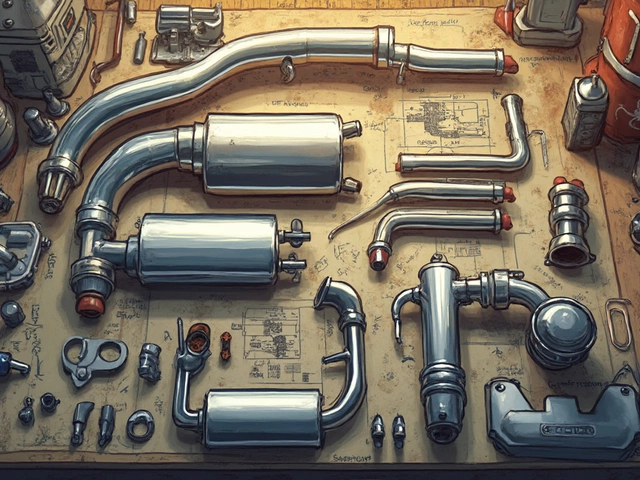2 into 1 Exhaust Horsepower Calculator
Calculate Your Potential Horsepower Change
Input your engine details to see if a 2 into 1 exhaust will improve performance or potentially reduce power.
Estimated Horsepower Change
Enter your engine details to see your results
When you hear the deep rumble of a 2 into 1 exhaust system, it’s easy to assume it’s making more power. But does it actually boost horsepower-or is it just louder? The answer isn’t simple. It depends on your engine, how the system is designed, and what you’re trying to achieve.
What Is a 2 into 1 Exhaust?
A 2 into 1 exhaust combines two exhaust pipes from separate cylinders into a single pipe before the muffler. It’s common on V-twin motorcycles, some older cars, and custom builds. The goal? To reduce weight, simplify the layout, and sometimes improve exhaust flow.
But here’s the catch: engines don’t just need to expel gas-they need to breathe efficiently. Each cylinder produces exhaust pulses at specific intervals. In a 4-stroke engine, those pulses should ideally stay separated to avoid backpressure and scavenging issues. When you merge them too early, you risk messing with that timing.
How Exhaust Flow Affects Horsepower
Horsepower isn’t just about how much gas you burn-it’s about how well you can clear the spent gases and pull in fresh air. A good exhaust system helps with scavenging: the process where outgoing exhaust gases create a low-pressure zone that pulls the next charge out of the cylinder faster.
Factory exhausts are designed for emissions, noise, and cost-not performance. Aftermarket systems, including 2 into 1 setups, often have larger-diameter pipes and smoother bends. That alone can help. But if the merge point is poorly designed, you lose more than you gain.
Real-world dyno tests on Harley-Davidson Sportsters show that a well-tuned 2 into 1 system can add 5-10 horsepower over stock, mostly in the mid-range. But a cheap, poorly engineered version? It might drop torque by 3-8 hp and make the engine run hotter.
Why Timing Matters: Pulse Interference
Not all engines handle merging well. V-twins with 45-degree or 90-degree cylinder angles often work fine with 2 into 1 systems because their exhaust pulses are naturally spaced apart. But parallel twins or inline-fours? Those pulses come too close together. Merging them early causes pulse interference-where one cylinder’s exhaust wave pushes back into the other cylinder’s exhaust port.
This creates backpressure. More backpressure means less room for fresh air-fuel mix to enter. Less air-fuel mix? Less power. That’s why many high-performance inline-fours use 4 into 2 into 1 or 4-into-4 systems-they preserve pulse separation longer.
On a 2024 Yamaha XSR900, switching from a stock 2-into-2 to a 2-into-1 system without rejetting or remapping dropped peak torque by 4.2 lb-ft. The rider thought it would be faster. It wasn’t.

It’s Not Just the Pipes-It’s the Tune
Changing your exhaust isn’t like swapping tires. Your engine’s ECU (or carburetors) expects a certain amount of backpressure and exhaust flow. If you install a 2 into 1 system and don’t adjust the fuel map, you’ll run lean or rich.
Lean conditions-too much air, not enough fuel-can cause overheating, detonation, and even bent valves. Rich conditions flood the engine, kill throttle response, and foul spark plugs.
On a 2023 Indian Scout, a 2 into 1 exhaust increased peak horsepower by 7.1 hp-but only after a custom tune. Without it, the bike ran rough at low RPM and lost 3 hp. The exhaust didn’t make the power. The tune did.
When Does a 2 into 1 Actually Help?
There are cases where it works well:
- Stock or mildly modified V-twins (Harley, Indian, Ducati V-twins)
- Engines with long, tuned header pipes that maintain pulse separation after the merge
- Custom builds with equal-length primaries and proper collector design
- When paired with a proper ECU tune or carb rejetting
Some manufacturers like Vance & Hines and K&N design 2 into 1 systems with precise merge angles and collector chambers that mimic the timing of a 4-into-1. These systems can deliver real gains-up to 12 hp on tuned bikes.
But most off-the-shelf 2 into 1 kits sold on eBay or Amazon? They’re just cheaper pipes with no engineering. They might look cool, but they often hurt performance.

What You Should Do Before Installing One
Don’t just buy a 2 into 1 exhaust and bolt it on. Follow these steps:
- Check your engine type. V-twins? Good candidate. Inline-fours? Think twice.
- Look for systems designed for your exact model. Generic kits rarely work well.
- Verify the manufacturer provides dyno results for your bike or car.
- Plan for a tune. Even if it’s a simple fuel controller like a Power Commander or TuneECU.
- Test it on a dyno before and after. Don’t guess-measure.
One Adelaide rider spent $800 on a 2 into 1 exhaust for his 2021 Honda CB650R. After a $200 tune, he gained 4.5 hp at 5,500 RPM. Without the tune? He lost 2 hp. The exhaust didn’t fail-it just needed the right setup.
Alternatives to Consider
If you want real power gains without the guesswork:
- 4 into 2 into 1 - Better pulse control for twins, used on performance cruisers.
- Header upgrades - Equal-length headers with tuned lengths often outperform 2 into 1 mergers.
- Full system with ECU tune - The gold standard. Removes restrictions from manifold to tailpipe.
- Slip-on mufflers - Minimal gain, but legal, cheap, and easy to reverse.
On a 2024 BMW R1250RT, a full exhaust system with remapping added 11 hp and 14 lb-ft of torque. A 2 into 1 slip-on added 2 hp and killed low-end torque. The difference? Control.
Bottom Line: It Can Help-But Only If Done Right
A 2 into 1 exhaust doesn’t automatically make more horsepower. It can, but only if:
- It’s engineered for your specific engine
- The merge timing matches your exhaust pulses
- You re-tune the fuel system
- You test it on a dyno
Most people buy these systems for the sound and look. That’s fine. But if you want real power, don’t assume the pipe alone is the answer. The real magic is in the tuning, the design, and the matching of components-not just the number of pipes merging into one.
Go in with eyes open. Measure before and after. And if you’re not tuning, you’re probably losing more than you’re gaining.
Does a 2 into 1 exhaust always increase horsepower?
No. A 2 into 1 exhaust only increases horsepower if it’s properly designed for your engine, includes tuned headers and collectors, and is paired with a correct fuel map. Many cheap versions reduce power by creating backpressure or disrupting exhaust pulse timing.
Is a 2 into 1 exhaust better than a 2 into 2?
It depends. A 2 into 2 system keeps exhaust pulses separate, which helps scavenging and low-end torque. A 2 into 1 can improve mid-range power on V-twins if engineered well, but often sacrifices low-end response. For street riding, 2 into 2 usually feels more responsive. For cruising or drag setups, a tuned 2 into 1 can be better.
Do I need to re-tune my engine after installing a 2 into 1 exhaust?
Yes. Changing exhaust flow alters backpressure and air-fuel ratios. Without a tune, your engine will likely run lean (risking damage) or rich (losing power). Even if your bike has fuel injection, the ECU needs to adjust fuel delivery to match the new exhaust characteristics.
Can a 2 into 1 exhaust damage my engine?
It can, if it’s poorly designed or installed without tuning. Lean conditions from increased exhaust flow can cause overheating, melted pistons, or burnt valves. Always use a reputable brand and get a tune. Avoid no-name kits from online marketplaces.
What’s the best way to test if a 2 into 1 exhaust works?
Use a dynamometer before and after installation. Look at torque and horsepower curves across the RPM range-not just peak numbers. A good system will improve mid-range power without dropping low-end torque. If peak power goes up but you lose acceleration off the line, the system isn’t helping your real-world riding.




